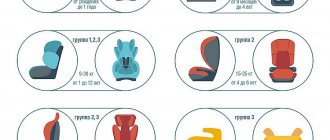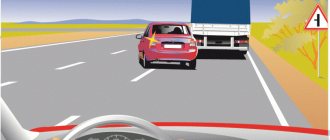A fine for transporting people in a cargo van is a sanction that can be imposed on a citizen in order to ensure the safety of other people. The road is a high-risk zone, and moving along it while in an unsuitable place is doubly dangerous. In emergency cases, when a person must get to another point as quickly as possible, he has to consider any options. And one of them is a trip not in the passenger seat, but in the back of a passing truck.
In what cases is transportation permitted?
Despite the fact that this method of travel is quite inconvenient, traveling in a cargo van is practiced at large enterprises where cargo is constantly transported. The person in the back most often plays the role of a forwarder or a logistics department employee who must accompany the goods and monitor their condition.
In other cases, transportation of people is necessary when moving from one place to another, or when urgently moving a large number of people to another facility. In fact, transporting people in a truck, in principle, is not a violation of traffic rules. But only if there are no violations in the equipment of passenger seats. If all the rules are followed, then the driver does not face a fine for violating the rules for transporting one or more passengers.
Here are the basic requirements.
- First of all, the person driving must have a category C license. If you need to transport eight or more people, you need a license with the letter D. Driving experience must not be less than three years.
- The cargo compartment must have attached side walls, called a platform.
- Passenger seats must be located strictly in accordance with the number of people transported. If there are more citizens than seats, then such transportation is prohibited.
- The seats should be located at a height of twenty to fifty centimeters from the floor. The minimum height of the side fence is eighty centimeters from the floor.
- Seat backs must be firmly reinforced and hold up well.
Amount of fine
The fine for a 3rd lane on a truck is 1,500 rubles. For this offense there is a possibility of payment at a discount. If you do it within 20 days from the date of receiving a copy of the resolution, you can pay the same amount - 750 rubles in any city in the Russian Federation, including Moscow and St. Petersburg.
In what cases will transportation be considered illegal?
Accordingly, if the truck does not have high guards or strong passenger seats, transporting even one citizen in this position is not permitted. The Code of Administrative Offenses as such does not have an article regulating the amount of this fine. Therefore, the charge will be brought under one of the parts of Article 12.23.
According to its provisions, it is possible to obtain a protocol for the transportation of passengers if they are located outside the vehicle itself or the cabin in which there may be people. For example, if citizens chose a cargo trailer for a passenger car or a sidecar for a cargo motorcycle as a passenger seat. The fines for improper transportation of people in a compartment intended for bulky items are also regulated by the provisions of this article.
The cost of a fine for the driver in this case is 1000 rubles.
Important! Transporting children in a cargo van that is not suitable for their needs is prohibited in any case. And here the fine amounts are much higher. Three thousand rubles is the amount of punishment for a driver who did not take care of the safety of a small passenger. If an official is found guilty, he will pay twenty-five thousand. And finally, if the protocol is drawn up for a legal entity, the amount of punishment will increase to one hundred thousand rubles.
Restrictions for trucks falling under category B
Category B is the most common, as it allows you to drive all types of passenger cars and some types of trucks. Characteristics they must meet:
- weight with trailer and people no more than 3500 kg;
- number of passenger seats up to 8;
- the presence of a trailer weighing up to 750 kg or more, if the total weight of the vehicle does not exceed 3.5 tons.
Unlike passenger vehicles, trucks have special requirements. For example, the speed in populated areas cannot be more than 60 km/h, outside the city - up to 90 km/h, and on a busy highway the limit is 110 km/h. If the road has 3 lanes or more, vehicles weighing up to 2.5 tons can only travel on the far left side. Unless it will be busy, and due to heavy traffic it will not be possible to take a place other than the adjacent lane, then this rule can be neglected. In addition, unlike cars, motorcycles and bicycles, parking a van near the sidewalk means you will incur a fine.
How should a truck be equipped to constantly transport people?
If the transportation of people in the back of a truck is permanent, then it needs to be retrofitted.
In addition to installing seats with strong backs and a side platform, you will need to close the body itself - pull up an awning or tarpaulin, all cracks in the floor will have to be straightened, and electricity will need to be installed into the body itself. It will be necessary to update the locking mechanisms, as well as install an alarm system to communicate with the driver in an emergency. An extra fire extinguisher wouldn't hurt. And in the cold season, the cargo compartment will need to be heated.
Additional technical equipment of the body means that passengers can be transported in it without any problems. To avoid getting fined for transporting people in an undesignated cargo van, you need to be prepared.
- 22.1
- 22.2
- 22.3
- 22.4
- 22.5
- 22.6
- 22.7
- 22.8
- 22.9
22. TRANSPORTATION OF PEOPLE
22.1
Transportation of people in the back of a truck must be carried out by drivers who have a license to drive vehicles of category “C” (when transporting more than 8 people, including passengers in the cabin, categories “C” and “D”) and experience driving vehicles of this category more than 3 years.
Note Military drivers are allowed to transport people in trucks in accordance with the established procedure.
22.2
The carriage of persons in the back of a flatbed truck is permitted if it is equipped in accordance with the Basic Provisions, but the carriage of children is permitted only in exceptional cases.
22.3
The number of people transported in the back of a truck, as well as in the interior of a bus carrying out transportation on an intercity, mountain, tourist or excursion route, and in the case of organized transportation of a group of children, should not exceed the number of seats equipped for sitting.
22.4
Before the trip, the driver of the truck must instruct passengers on the procedure for boarding, disembarking and placing in the back. You can start moving only after making sure that the conditions for the safe transportation of passengers are provided.
22.5
Travel in the back of a truck with a flatbed that is not equipped for transporting people is permitted only to persons accompanying the cargo or following its receipt, provided that they are provided with a seat located below the level of the sides
22.6
Organized transportation of a group of children must be carried out in accordance with special rules in a bus or truck with a van body, bearing the identification marks “Transportation of Children.” In this case, the children must be accompanied by an adult accompanying them
22.7
The driver is obliged to board and disembark passengers only after the vehicle has come to a complete stop, and to start driving only with the doors closed and not open them until the vehicle has come to a complete stop.
22.8
It is prohibited to transport people:
outside the cabin of a car (except for cases of transportation of people in the back of a truck with a flatbed or in a van), tractor, other self-propelled vehicles, on a cargo trailer, in a caravan trailer, in the back of a cargo motorcycle and outside the seating areas provided for by the design of the motorcycle;
in excess of the amount provided for by the technical characteristics of the vehicle
Author:
The technical specifications of the vehicle indicate the maximum number of passengers carried.
22.9
Transportation of children is permitted provided that their safety is ensured, taking into account the design features of the vehicle.
Transportation of children under 12 years of age in vehicles equipped with seat belts must be carried out using special child restraint devices appropriate for the weight and height of the child, or other means that allow the child to be fastened using seat belts provided for by the design of the vehicle, and on the front passenger car seat - only with the use of special child restraint devices.
It is prohibited to transport children under 12 years of age on the back seat of a motorcycle.
Author:
In the front seat of a passenger car, children under 12 years of age are allowed to be transported only in special child seats. Child restraints are attached to the passenger seat and reliably secure the child, thereby ensuring his safety while driving. In the back, a child of the specified age must be transported either in a special seat, or he must be fastened with a seat belt. In order for the belt to securely fix the child, the Rules require the use of additional means (for example, special pillows attached to the seat)
Table of contents
Fine for transporting people in a cargo van - Motorist's Handbook
Citizens traveling across the vast expanses of the planet and visiting, for example, Asia, have probably observed the following picture more than once: the interior of the car is jam-packed with people, and those who still couldn’t squeeze in are sitting in the back.
And it doesn’t matter at all whether it’s a trailer, a standard open pickup truck, or a van body. This article was written in order to figure out whether this can be done in our country and what are the consequences of ignoring the rules for transporting satellites?
Dear readers! Our articles talk about typical ways to resolve legal issues, but each case is unique.
If you want to find out how to solve your particular problem, please use the online consultant form on the right or call
+7
It's fast and free!
How should freight transport be equipped?
A fine for overloading is an unpleasant sanction for a motorist, so you should understand what prohibitions are prescribed by the government in the traffic rules of the Russian Federation.
To fulfill the second paragraph, a limited number of seats is provided in the case of passenger cars or a limitation on technical characteristics for large public transport, such as buses, trolleybuses or trams. Which article regulates the fine for incorrect transportation, violation of the rules for transporting passengers? This article is Article 12.23 of the Code of Administrative Offenses of the Russian Federation “Violation of the rules for transporting people.”
Fine for transporting people in the back of a car
Citizens traveling across the vast expanses of the planet and visiting, for example, Asia, have probably observed the following picture more than once: the interior of the car is jam-packed with people, and those who still couldn’t squeeze in are sitting in the back.
And it doesn’t matter at all whether it’s a trailer, a standard open pickup truck, or a van body. This article was written in order to figure out whether this can be done in our country and what are the consequences of ignoring the rules for transporting satellites?
Dear readers! Our articles talk about typical ways to resolve legal issues, but each case is unique.
If you want to find out how to solve your particular problem, please use the online consultant form on the right or call
+7
It's fast and free!
Body types
In one of our articles we talked about what categories of vehicles exist. We also told you in what cases, if it is necessary to transport people, it is necessary category in addition to the standard one .
Transportation of people can only be carried out in vehicles whose bodies allow the safe transportation of people . The most popular types include:
- Sedan . An ordinary two or four door car, which can be transported on the front and rear sofas.
- Station wagon . A utility vehicle that requires a large trunk. Passengers can only be transported in the cabin.
- Minivan . Just like a station wagon, it belongs to the cargo-passenger type of car, but it has more seats. Carriage in luggage compartment is also prohibited.
- Cabover body . Small “cars” designed to transport people and equipped with appropriate devices to ensure safety and comfort.
- Van . This closed vehicle has a partition that protects the cargo from the people sitting in it. People cannot be transported in the cargo compartment.
- Pickup . It looks like a van, only the cargo compartment is open. Transportation of people can only be carried out in the cabin.
How are people allowed to be transported?
As we have already said, transportation can only be carried out in bodies designed for this purpose. Seats and safety belts are required to ensure safety. To ensure safe movement, the law provides for penalties for violating transportation rules.
Usually, people who do not have enough space in the cabin, or workers accompanying the cargo, move in the cargo compartment. In general, riding in the back of a truck is not prohibited , but several points must be observed.
The fine for transporting passengers in a cargo van will not be charged in the following cases:
- The driver of the vehicle has at least 3 years Category D is required only if you need to transport more than 8 people (excluding the driver). If less than eight people are transported, category C will be sufficient .
- In the corresponding compartment, special platforms should be installed that look like side walls.
- The number of seats must be no less than the number of passengers carried .
- The mandatory height at which the seats must be attached should not be less than 20-50cm . The side railing must be at least 80cm .
- It is necessary to thoroughly fasten the seat backs to secure the seating of passengers.
Cases of illegal transportation
In all cases that do not meet the above requirements, transportation will be considered illegal . Under no circumstances should people be transported in trailers or unequipped bodies. In addition to the fact that this threatens the driver with a fine, it is also dangerous for the people themselves who agreed to such a means of transportation.
Remember! You cannot carry people outside the cab, outside the cab of a tractor, self-propelled vehicle, or in the cargo compartment of a motor vehicle.
This rule applies to all cases without exception. This also applies to the transport of people with disabilities. No reason will be considered valid if you do not provide adequate security for your companions.
Please note that the law enforcement officers especially strictly punish drivers who are negligent in transporting children.
Fines
The fine for transporting people in a cargo van that is not designed for this purpose and does not have the proper equipment is established based on certain circumstances:
- If you simply violate the rules for transporting people, you will have to pay five hundred rubles .
- If transportation is carried out outside an equipped cabin, the fine increases from five hundred rubles to a thousand .
- If incorrect transportation of minor passengers is detected, the driver undertakes to pay an administrative fine in the amount of three thousand rubles . Regarding officials, the law obliges them to pay 25 thousand rubles . A legal entity can also be punished and ordered to pay up to one hundred thousand rubles .
Possibility of evading a fine
If the transportation of people in the back of a truck, for which you were fined, was carried out, in your opinion, legally , you can challenge such a punishment within ten days from the date of the accusation.
You will have to prove that all requirements have been met , and, if necessary, provide witness testimony and video recordings. If you are unable to challenge the fine yourself, remember your legal right to seek help from lawyers who will help you assert your rights and drop illegal charges.










